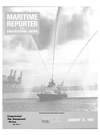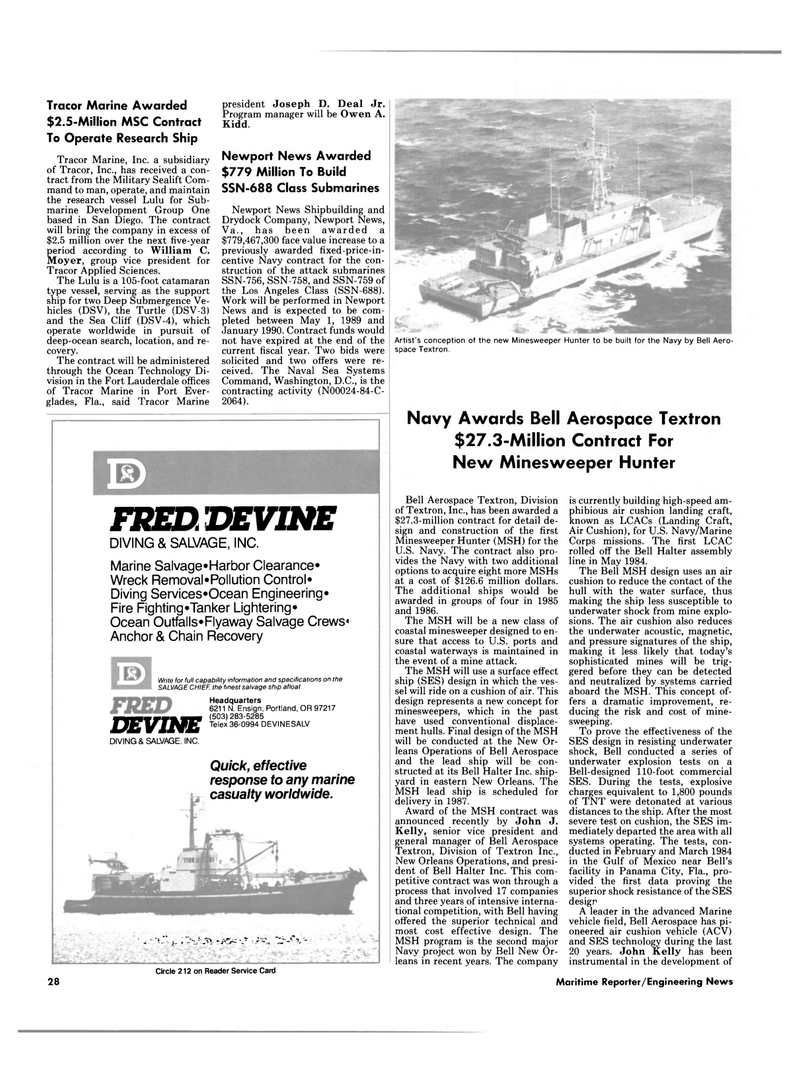
Page 26: of Maritime Reporter Magazine (January 15, 1985)
Read this page in Pdf, Flash or Html5 edition of January 15, 1985 Maritime Reporter Magazine
Tracor Marine Awarded $2.5-Million MSC Contract
To Operate Research Ship
Tracor Marine, Inc. a subsidiary of Tracor, Inc., has received a con- tract from the Military Sealift Com- mand to man, operate, and maintain the research vessel Lulu for Sub- marine Development Group One based in San Diego. The contract will bring the company in excess of $2.5 million over the next five-year period according to William C.
Moyer, group vice president for
Tracor Applied Sciences.
The Lulu is a 105-foot catamaran type vessel, serving as the support ship for two Deep Submergence Ve- hicles (DSV), the Turtle (DSV-3) and the Sea Cliff (DSV-4), which operate worldwide in pursuit of deep-ocean search, location, and re- covery.
The contract will be administered through the Ocean Technology Di- vision in the Fort Lauderdale offices of Tracor Marine in Port Ever- glades, Fla., said Tracor Marine president Joseph D. Deal Jr.
Program manager will be Owen A.
Kidd.
Newport News Awarded $779 Million To Build
SSN-688 Class Submarines
Newport News Shipbuilding and
Drydock Company, Newport News,
Va., has been awarded a $779,467,300 face value increase to a previously awarded fixed-price-in- centive Navy contract for the con- struction of the attack submarines
SSN-756, SSN-758, and SSN-759 of the Los Angeles Class (SSN-688).
Work will be performed in Newport
News and is expected to be com- pleted between May 1, 1989 and
January 1990. Contract funds would not have expired at the end of the current fiscal year. Two bids were solicited and two offers were re- ceived. The Naval Sea Systems
Command, Washington, D.C., is the contracting activity (N00024-84-C- 2064).
ID
FRED DEVINE
DIVING & SALVAGE, INC.
Marine Salvage*Harbor Clearance-
Wreck Removal •Pollution Control-
Diving Services-Ocean Engineering-
Fire Fighting-Tanker Lightering-
Ocean Outfalls-Flyaway Salvage Crews«
Anchor & Chain Recovery
H) Write for full capability information and specifications on the
SALVAGE CHIEF, the finest salvage ship afloat
Headquarters 6211 N. Ensign. Portland, OR 97217 (503)283-5285
Telex 36-0994 DEVINESALV DEVINE
DIVING & SALVAGE, INC.
Quick, effective response to any marine casualty worldwide. -•„..-'C,f: It-*-*,'-.
Artist's conception of the new Minesweeper Hunter to be built for the Navy by Bell Aero- space Textron.
Navy Awards Bell Aerospace Textron $27.3-Million Contract For
New Minesweeper Hunter
Circle 212 on Reader Service Card
Bell Aerospace Textron, Division of Textron, Inc., has been awarded a $27.3-million contract for detail de- sign and construction of the first
Minesweeper Hunter (MSH) for the
U.S. Navy. The contract also pro- vides the Navy with two additional options to acquire eight more MSHs at a cost of $126.6 million dollars.
The additional ships would be awarded in groups of four in 1985 and 1986.^
The MSH will be a new class of coastal minesweeper designed to en- sure that access to U.S. ports and coastal waterways is maintained in the event of a mine attack.
The MSH will use a surface effect ship (SES) design in which the ves- sel will ride on a cushion of air. This design represents a new concept for minesweepers, which in the past have used conventional displace- ment hulls. Final design of the MSH will be conducted at the New Or- leans Operations of Bell Aerospace and the lead ship will be con- structed at its Bell Halter Inc. ship- yard in eastern New Orleans. The
MSH lead ship is scheduled for delivery in 1987.
Award of the MSH contract was announced recently by John J.
Kelly, senior vice president and general manager of Bell Aerospace
Textron, Division of Textron Inc.,
New Orleans Operations, and presi- dent of Bell Halter Inc. This com- petitive contract was won through a process that involved 17 companies and three years of intensive interna- tional competition, with Bell having offered the superior technical and most cost effective design. The
MSH program is the second major
Navy project won by Bell New Or- leans in recent years. The company is currently building high-speed am- phibious air cushion landing craft, known as LCACs (Landing Craft,
Air Cushion), for U.S. Navy/Marine
Corps missions. The first LCAC rolled off the Bell Halter assembly line in May 1984.
The Bell MSH design uses an air cushion to reduce the contact of the hull with the water surface, thus making the ship less susceptible to underwater shock from mine explo- sions. The air cushion also reduces the underwater acoustic, magnetic, and pressure signatures of the ship, making it less likely that today's sophisticated mines will be trig- gered before they can be detected and neutralized by systems carried aboard the MSH. This concept of- fers a dramatic improvement, re- ducing the risk and cost of mine- sweeping.
To prove the effectiveness of the
SES design in resisting underwater shock, Bell conducted a series of underwater explosion tests on a
Bell-designed 110-foot commercial
SES. During the tests, explosive charges equivalent to 1,800 pounds of TNT were detonated at various distances to the ship. After the most severe test on cushion, the SES im- mediately departed the area with all systems operating. The tests, con- ducted in February and Marcb 1984 in the Gulf of Mexico near Bell's facility in Panama City, Fla., pro- vided the first data proving the superior shock resistance of the SES desigr
A leader in the advanced Marine vehicle field, Bell Aerospace has pi- oneered air cushion vehicle (ACV) and SES technology during the last 20 years. John Kelly has been instrumental in the development of 28 Maritime Reporter/Engineering News

 25
25

 27
27
